Spondylolysis in Adolescents: A Ballet Dancer’s Recovery Journey
Written by: Dr Lau Leok Lim (drlauspineclinic@gmail.com)
Location: Singapore
Date: 13 September 2025
Spondylolysis—a stress fracture of the pars interarticularis—is one of the most common causes of back pain in adolescents, especially those engaged in high-performance sports or dance. In Singapore, ballet dancers and gymnasts are frequently affected due to repetitive lumbar extension and axial loading. Early diagnosis and tailored treatment are essential to prevent progression to spondylolisthesis or chronic disability. This guide explores clinical features, imaging, treatment options, and a real-life recovery case to help families and clinicians make informed decisions.
What Is Spondylolysis?
- Stress fracture of the pars interarticularis (posterior vertebral arch)
- Most common at L5, followed by L4 and L3. It can happen in thoracic spine.
- Often bilateral and may progress to vertebral slippage
- Frequently underdiagnosed in active adolescents
Why It Happens
- Repetitive hyperextension and axial loading during dance or sport
- Immature bone structure in adolescents increases vulnerability
- Contributing factors:
- High training volume
- Poor core stability
- Biomechanical imbalance
Clinical Presentation
- Localized low back pain, worsened by extension movement of the lower back
- Pain during dance movements like arabesque or backbend, or simply carry too heavy load that body can bear
- Normal neurological exam unless slippage occurs
- May be misdiagnosed as muscular strain or discogenic pain (pain arises from the intervertebral disc)
Diagnostic Imaging
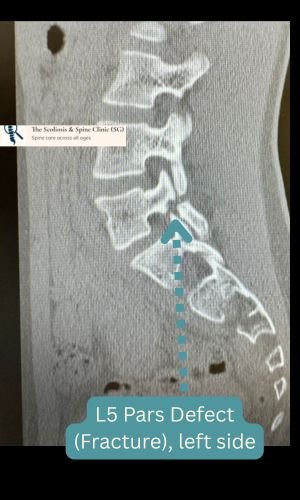
Axial CT scan revealing bilateral pars defects at L5 in a 14-year-old ballet dancer.
Case Insight
At just 14 years old, she was already dancing at an advanced grade – training 3-4 times a week, pushing her body to its limits in pursuit of perfection. For months, she’d been experiencing persistent backache. It wasn’t dramatic or sudden. Just a dull, nagging pain that lingered after training rehearsals, crept into her sleep, and slowly began to affect her performance and day-to-day activities. She attributed it to the rigors of ballet. After all, pain was part of the process, wasn’t it? But when the discomfort became constant, her family sought answers. At The Scoliosis & Spine Clinic, we examined and evaluated her condition thoroughly.
Advanced imaging confirmed bilateral L5 spondylolysis.
This wasn’t a fresh injury. All signs pointed to a fracture that had been present for some time, likely sustained through repetitive stress and extension during ballet training. There were no dramatic falls. No single moment of trauma. Just the cumulative toll of movement – the precision, and discipline— etched into the architecture of her spine and chipping away the bones at its weakest link – at the bony bridge that spans across the upper and lower joints.
“Sometimes, the body whispers before it shouts. And in this case, the fracture had been whispering for months.”
What we found was not uncommon in adolescent dancers: stress at the L5–S1 segment, likely from repetitive hyperextension and axial loading. Her spine was absorbing more than it should—without adequate recovery or core support.
Despite three months of non-operative management, her ache persisted. A decision was made to proceed with surgical repair- a non-fusion motion preserved technique – using direct pars fixation—a targeted approach to stabilize the fracture and restore spinal integrity while maintaining the flexibility.
She recovered well postoperatively, regaining strength and mobility without complication. At her two-year follow-up, she reported being completely ache-free, with no residual discomfort. More importantly, she had rejoined her dancing troupe and returned to full performance—graceful, confident, and pain-free.
“Surgery didn’t just heal the fracture—it gave her back her rhythm.”
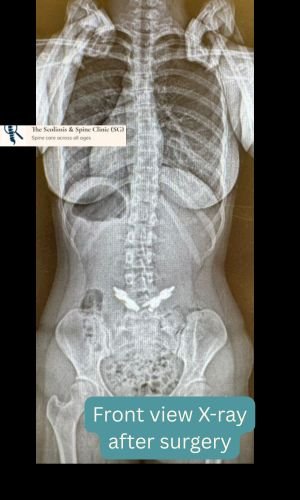
Post-operative PA view demonstrating restored vertebral alignment and hardware placement.
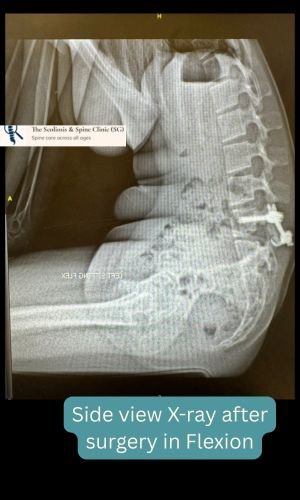
Side view radiograph of the lower back in flexion confirms segmental stability at the site of previous fracture.
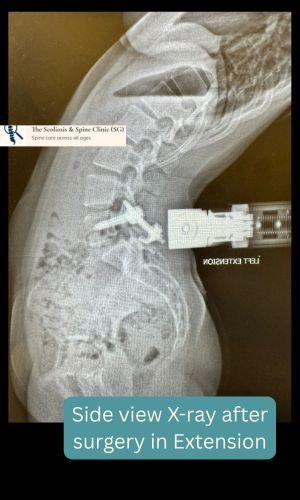
Side view radiograph in extension of the lower back shows preserved lumbar motions.
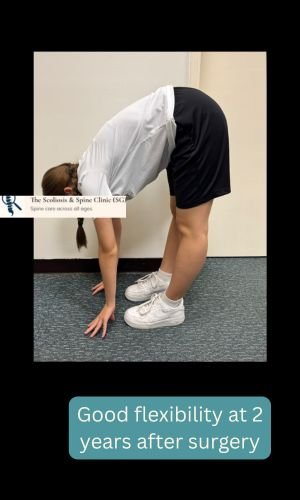
Clinical image showing full lumbar extension recovery at 2 years after surgery.
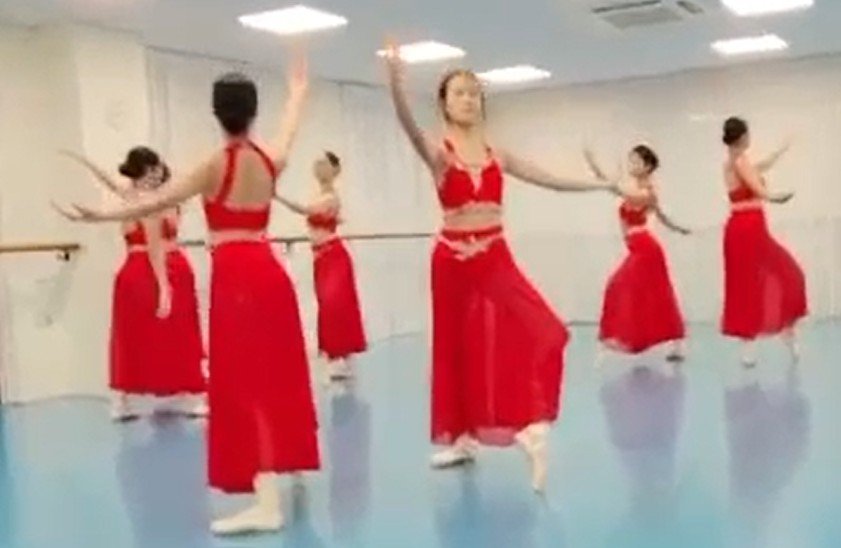
Watch: Recovery Journey of a 14-Year-Old Ballet Dancer – A real-life glimpse into her journey in returning to elite performance following spine surgery for spondylolysis.
Treatment Options
- Conservative: Bracing, physiotherapy, core strengthening, activity modification
- Surgical: Indicated for persistent pain or instability
- Direct pars repair with screw fixation
- Avoids fusion and preserves motion segment
- Minimally invasive techniques preferred
Final Thoughts
Spondylolysis is a leading cause of back pain in adolescent dancers and athletes. Early recognition, appropriate imaging, and individualized treatment are essential. With timely intervention, full recovery and return to sport are achievable—even in elite performers.
Frequently Asked Questions (FAQ)
Can spondylolysis heal without surgery?
Yes. Many adolescent cases respond well to non-operative treatment such as rest, bracing, physiotherapy, and activity modification. Surgery is considered only when symptoms are persistent or spinal stability is compromised.
Is spondylolysis common in dancers and athletes?
Absolutely. Ballet dancers, gymnasts, and athletes involved in repetitive lumbar extension are at higher risk due to biomechanical stress on the pars interarticularis.
What imaging is best for diagnosis?
CT scans are the gold standard for detecting pars fractures. MRI may be used to assess associated disc changes or inflammation. X-rays often miss early-stage defects.
Will my child be able to return to sport?
In most cases, yes. With timely diagnosis and appropriate treatment—whether conservative or surgical—adolescents can recover fully and resume high-level activity, including competitive dance and sport.
Is surgery safe for young patients?
Yes. When performed by experienced spine surgeons, direct pars repair is safe and motion-preserving. Minimally invasive techniques reduce recovery time and protect adjacent segments.
Concerned About Adolescent Back Pain?
If your child or teen is experiencing persistent back pain, reduced mobility, or difficulty performing in dance or sport, spondylolysis may be the underlying cause. These stress fractures are often missed without advanced imaging and specialist evaluation.
At The Scoliosis & Spine Clinic, we offer precise diagnosis and tailored treatment for adolescent spine conditions—including pars fractures, disc herniation, and growth-related deformities.
📅 Book a Consultation with Dr LauDr Lau Leok Lim is an Orthopaedic Surgeon based in Singapore, with subspecialty expertise in paediatric and adolescent spine care. Trusted by families, referring clinicians, and international peers.
📍 The Scoliosis & Spine Clinic | Singapore
📧 drlauspineclinic@gmail.com
💬 Preferred contact:
WhatsApp Dr Lau
